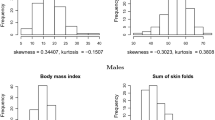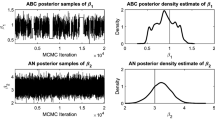Abstract
We study the tail behavior of distributions in the domain of attraction of bivariate extreme value distributions (this includes bivariate extreme value distributions themselves). We provide results on finite approximations of the tail behavior and its analytical shape. The results could form a basis to improve current statistical modeling of bivariate extreme values.
Similar content being viewed by others
References
Clayton, D.G., “A model for association in bivariate life tables and its application in epidemiological studies of familial tendency in chronic disease incidence,” Biometrika 65, 141-145, (1978).
Coles, S.G. and Tawn, J.A., “Modeling extreme multivariate events,” Journal of the Royal Statistical Society B 53, 377-392, (1991).
Gumbel, E.J., “Bivariate exponential distributions,” Journal of the American Statistical Association 55, 698-707, (1960).
Joe, H., “Families of min-stable multivariate exponential and multivariate extreme value distributions,” Statistics and Probability Letters 9, 75-81, (1990).
Joe, H., Smith, R.L., and Weissman, I., “Bivariate threshold methods for extremes,” Journal of the Royal Statistical Society B 54, 171-183, (1992).
Ledford, A.W. and Tawn, J.A., “Statistics for near independence in multivariate extreme values,” Biometrika 83, 169-187, (1996).
Morgenstern, D., “Einfache beispiele zweidimensionaler verteilungen,” Mitteilings-blatt fur Mathematische Statistik 8, 234-235, (1956).
Oakes, D., “A model for association in bivariate survival data,” Journal of the Royal Statistical Society B 44, 414-422, (1982).
Oakes, D., “Semiparametric inference in a model for association in bivariate survival data,” Biometrika 73, 353-361, (1986).
Resnick, S.I., Extreme values, regular variation and point processes, New York: Springer Verlag, 1987.
Smith, R.L., Tawn, J.A. and Coles, S.G., “Markov chain models for threshold exceedances,” Biometrika 84, 249-268, (1997).
Tawn, J.A., “Bivariate extreme value theory: Models and estimation,” Biometrika 75, 397-415, (1988).
Author information
Authors and Affiliations
Rights and permissions
About this article
Cite this article
Nadarajah, S. Approximations for Bivariate Extreme Values. Extremes 3, 87–98 (2000). https://doi.org/10.1023/A:1009927321376
Issue Date:
DOI: https://doi.org/10.1023/A:1009927321376




